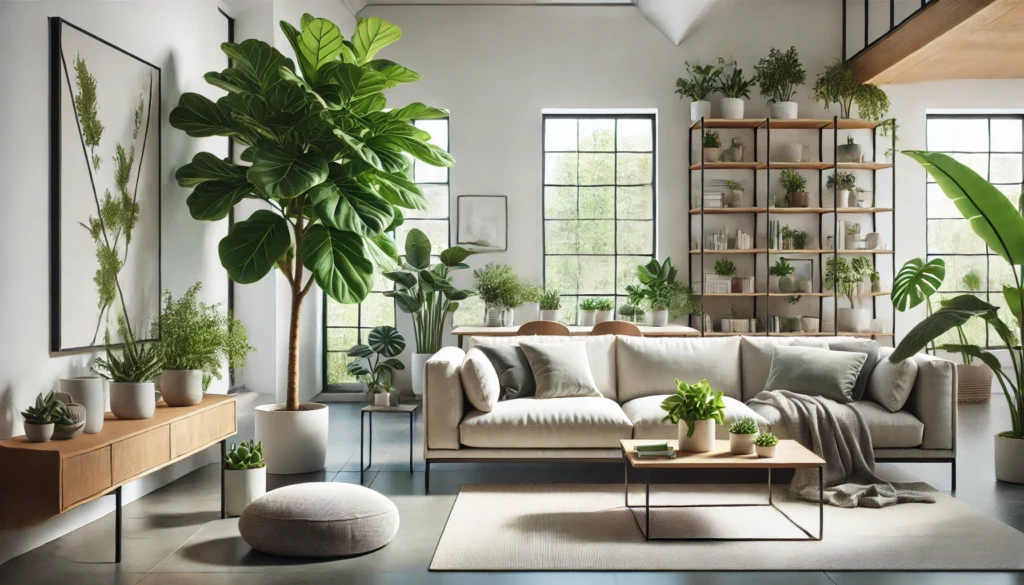
Balancing Furniture and Indoor Greenery: Tips for Harmonizing Home Decor and Plant Life
Picture a space where nature and design effortlessly come together, creating a serene and welcoming atmosphere. Balancing furniture and indoor greenery is the secret to transforming your home into a beautiful oasis. By thoughtfully placing plants alongside your furniture, you can breathe life into any room, adding color, texture, and vibrancy. But how do you create a perfect balance? This article will guide you through the process, offering practical tips to harmonize your plants with your furniture, ensuring your home feels both stylish and full of life. Let’s explore how to make nature an essential part of your decor.
Table of Contents
ToggleWhy Balancing Furniture and Indoor Greenery Matters:
Balancing furniture and indoor greenery isn’t just about aesthetics—it’s about creating a space that feels both alive and harmonious 🌿. Here’s why it matters:
Boosts Aesthetic Appeal
Plants add vibrant colors and textures, turning any room into a visually stunning space 🌸. When paired correctly with your furniture, they bring balance and depth, making your decor feel complete and thoughtful.
Improves Air Quality
Plants naturally purify the air by absorbing toxins and releasing oxygen 🌱. This means a healthier environment for you and your family, especially in spaces where you spend a lot of time.
Creates a Calm, Inviting Atmosphere
A well-balanced space with plants can promote relaxation and reduce stress 🌼. The combination of greenery with cozy furniture creates a peaceful, welcoming vibe that helps you unwind after a long day.
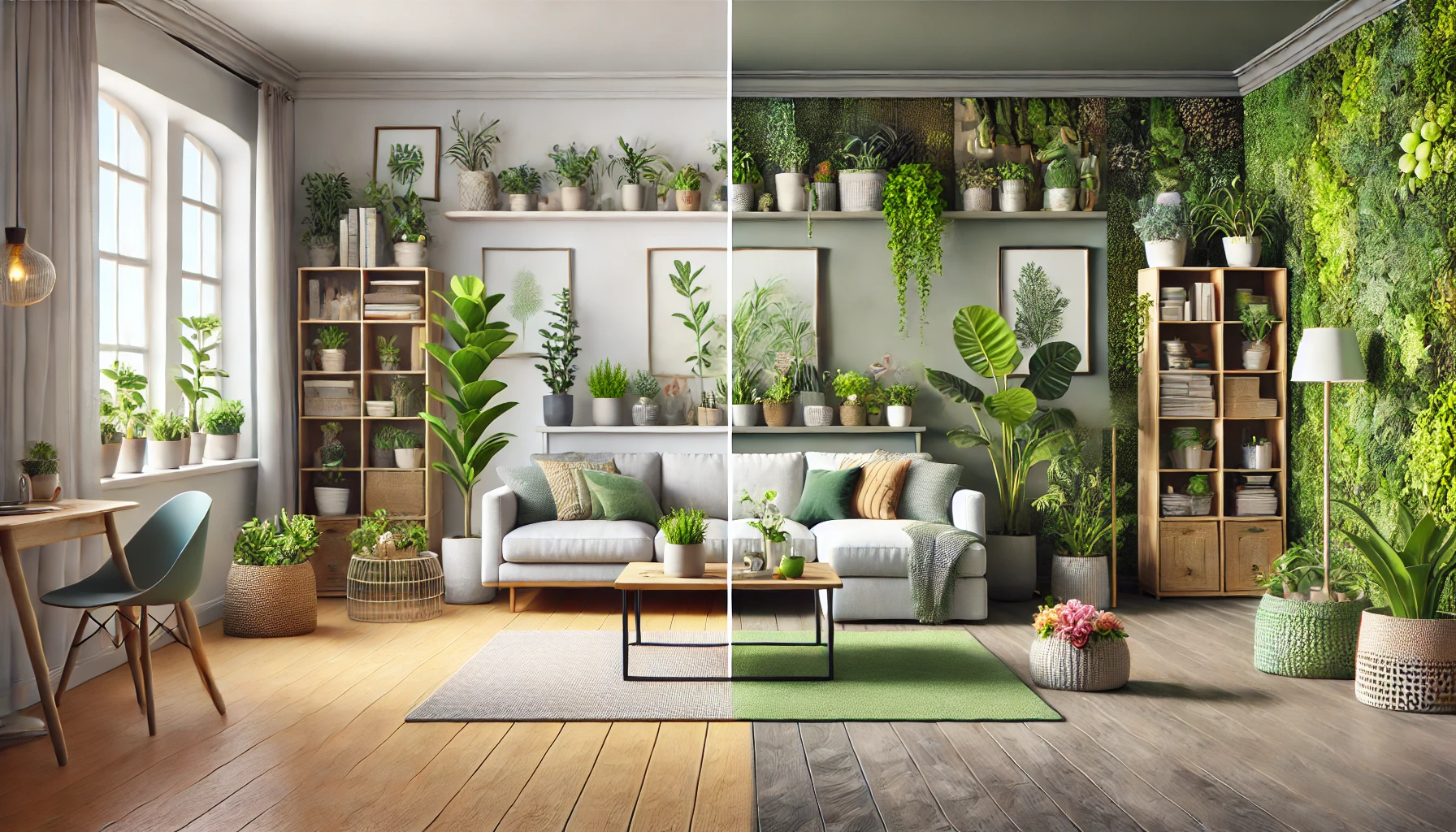
In short, when done right, balancing furniture and indoor greenery can turn your home into a cozy, stylish, and healthy retreat 🌺.
Understanding the Relationship Between Furniture and Plants:
To create a harmonious space, it’s important to understand how furniture and plants work together. Here’s how to make that relationship flourish:
Complement Your Furniture Style
Different furniture styles pair well with different types of plants 🌿. For example, modern minimalist furniture pairs beautifully with sleek plants like succulents, while vintage or boho furniture complements lush, leafy plants like ferns or ivy 🌱. Think about the overall vibe of your room when selecting plants.
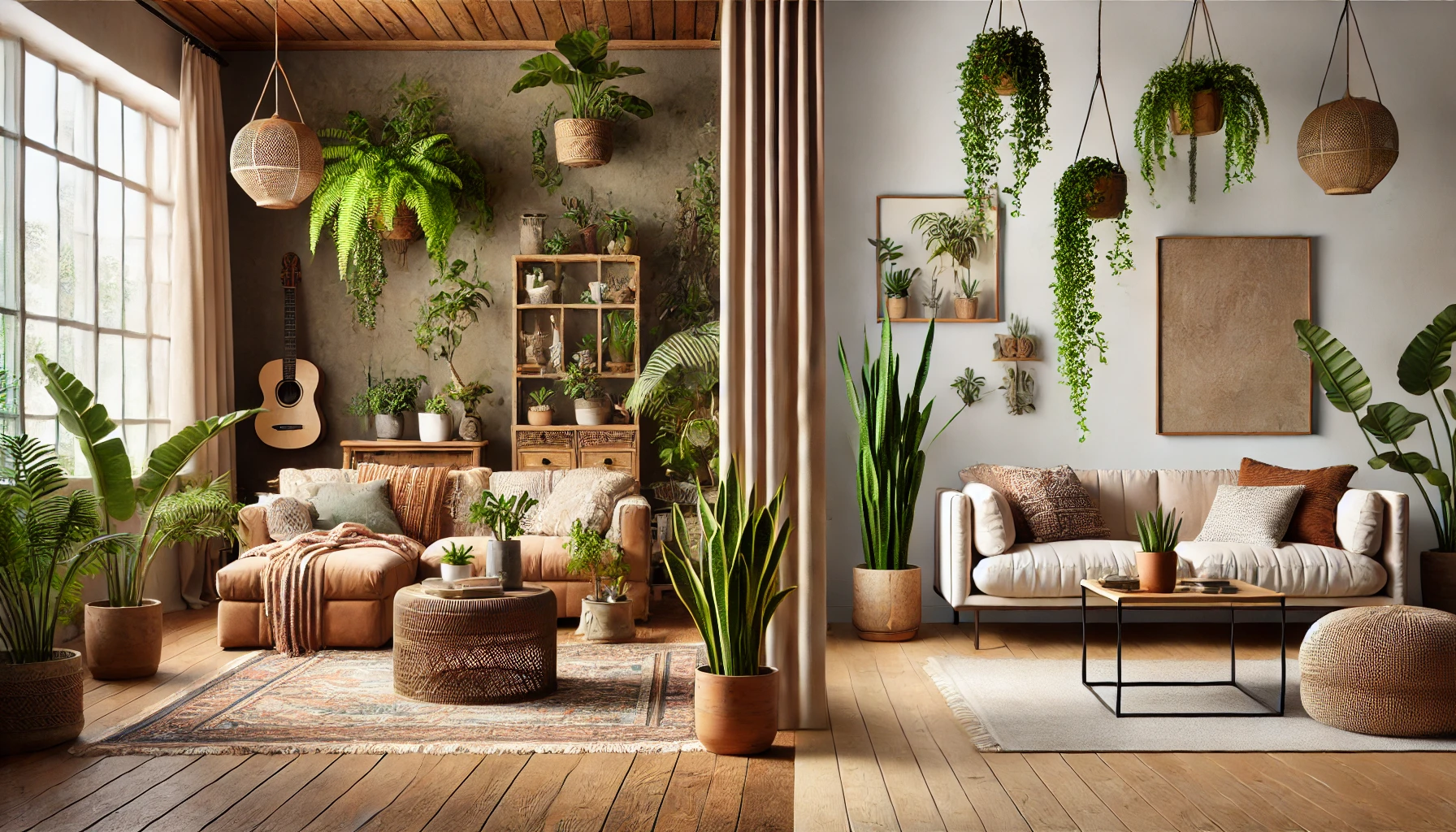
Room Functionality Matters
Consider how each room is used when choosing plants 🛋️. In a living room, large statement plants like a fiddle leaf fig can create a bold focal point. In a bedroom, smaller, low-maintenance plants like pothos or peace lilies work well without overwhelming the space.
Create Visual Balance
Avoid overcrowding spaces with plants. A few well-placed plants can create balance, but too many can make the room feel cramped 🌼. Mix different heights, textures, and sizes to create a pleasing, natural flow alongside your furniture.
When furniture and plants complement each other, your space will feel cohesive and thoughtfully designed 🌻.
Tips for Integrating Plants into Your Furniture Setup: 🌿✨
Bringing plants into your home isn’t just about placing them anywhere—strategic placement can enhance both your decor and plant health. Here’s how to seamlessly integrate greenery with your furniture:
- Start with Large Furniture Pieces 🛋️ – Position tall plants like fiddle leaf figs or rubber trees near sofas, bookshelves, or entertainment centers to create balance without cluttering small spaces.
- Use Different Heights & Layers 🌱 – Mix and match plant sizes! Place taller plants beside couches, medium-sized plants on side tables, and small ones on shelves or coffee tables for a dynamic, layered look.
- Make Plants a Focal Point 🎯 – Highlight statement plants in key areas like empty corners, entryways, or beside furniture pieces. A large monstera or a cascading pothos can add character to any room.
- Incorporate Hanging & Wall Plants 🪴 – If floor space is limited, use hanging planters or wall-mounted shelves with trailing plants like string of pearls or ivy to keep greenery within view without taking up valuable space.
- Pair Plants with Functional Decor 🏡 – Style plants alongside decor items like lamps, books, or candles. For example, a snake plant on a bedside table or a ZZ plant on a console table can enhance the decor without overwhelming the setup.
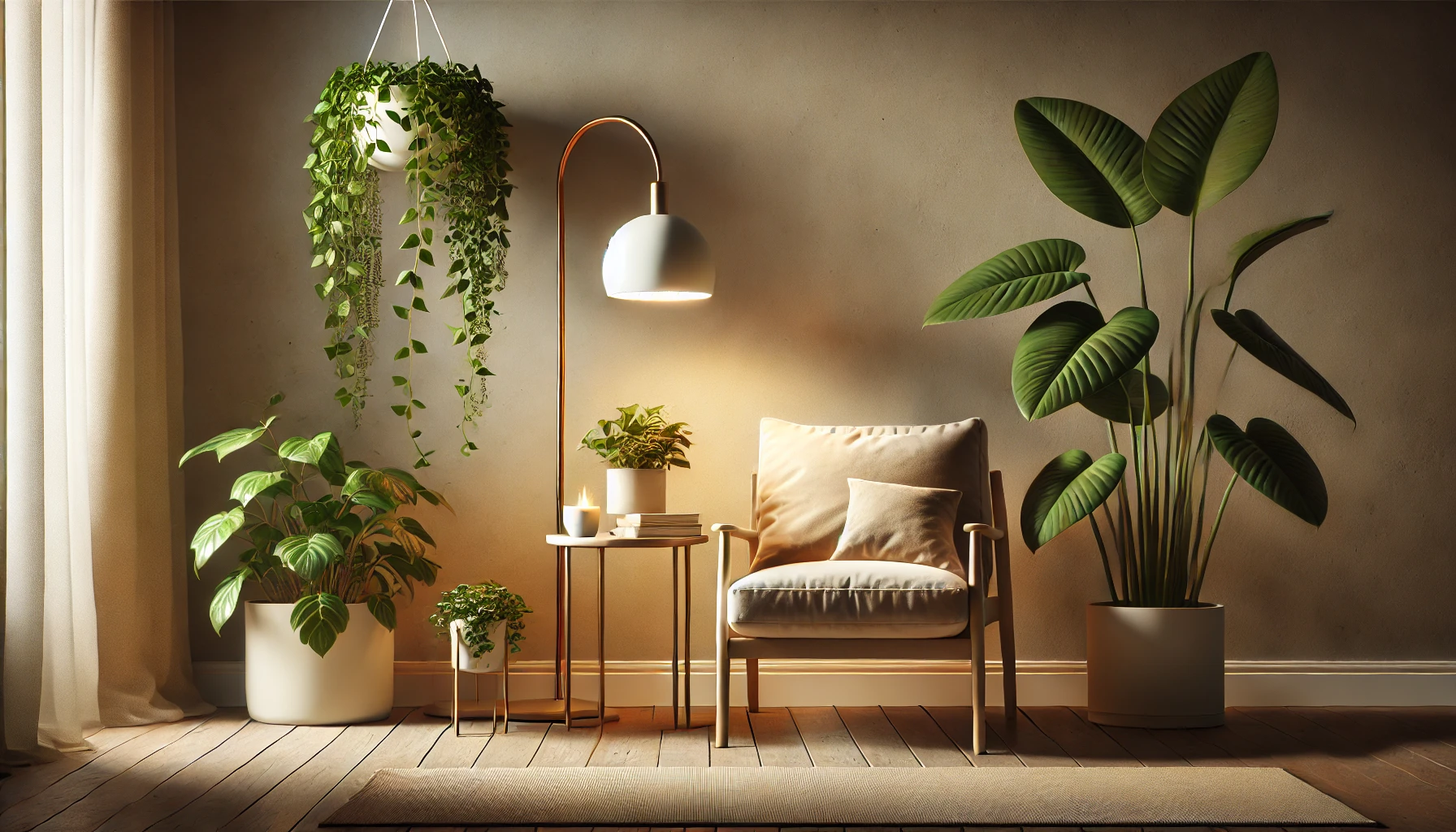
By thoughtfully integrating plants into your furniture layout, you can create a balanced, refreshing, and stylish home 🌸.
Choosing the Right Plants for Different Spaces 🌿🏡
Not all plants thrive in the same environment, and choosing the right ones for each space is key to a balanced, stylish home. Here’s how to match plants to different rooms and conditions:
🌞 Bright, Sunlit Spaces (Living Room, Kitchen, Balcony)
- Best Plants: Fiddle Leaf Fig, Bird of Paradise, Aloe Vera, Succulents
- Why? These plants love natural light and add a vibrant, airy feel to open spaces. Large plants like fiddle leaf figs can make a bold statement, while succulents add charm to small areas.
🌥️ Low-Light & Cozy Corners (Bedroom, Hallway, Office)
- Best Plants: Snake Plant, ZZ Plant, Pothos, Peace Lily
- Why? These plants thrive in low-light conditions and require minimal care. Plus, the snake plant and peace lily help purify the air, promoting a calming atmosphere—perfect for bedrooms or workspaces.
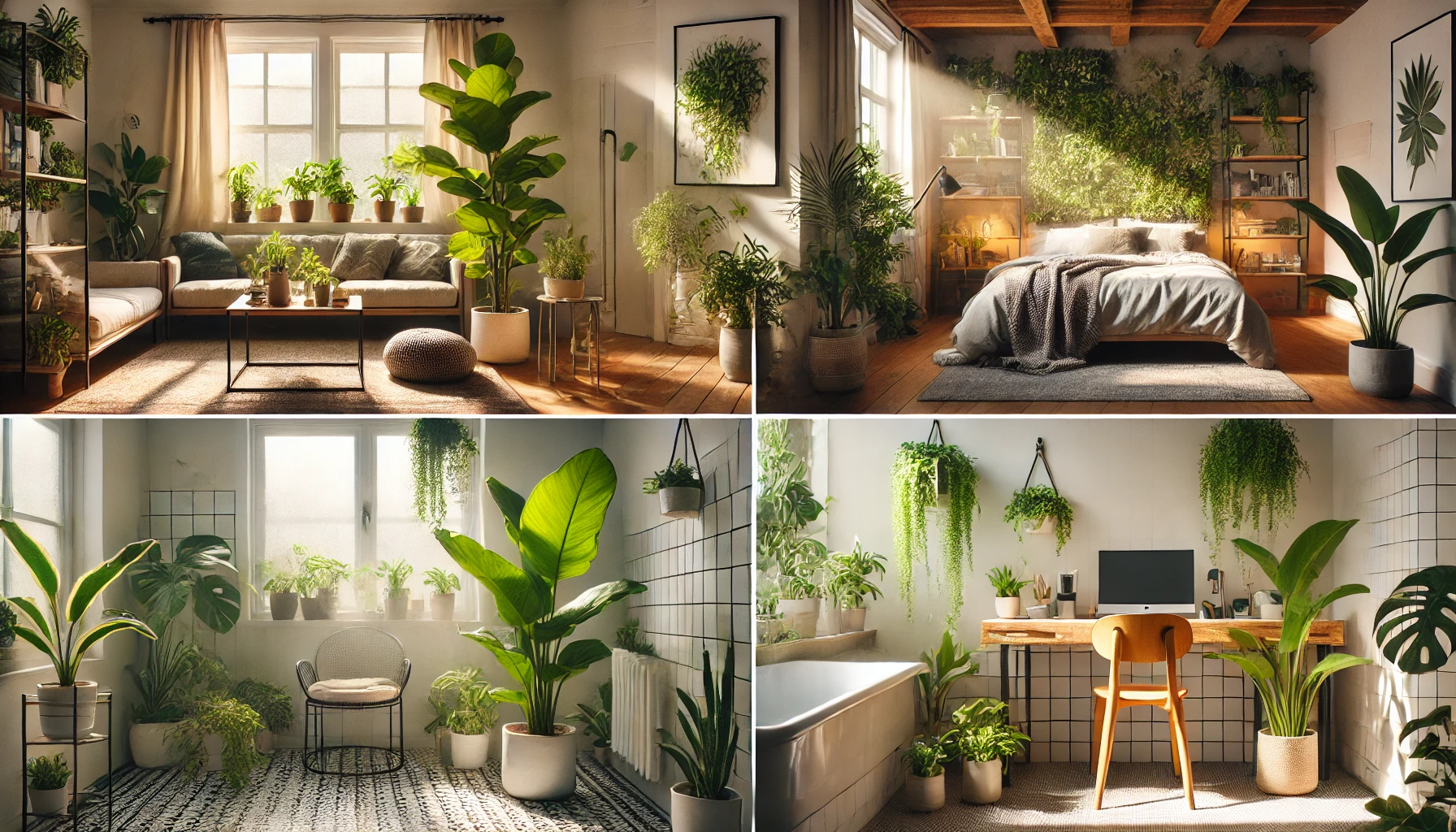
🚿 Humid & Moist Areas (Bathroom, Laundry Room)
- Best Plants: Boston Fern, Spider Plant, Orchids, Calathea
- Why? These plants love moisture and thrive in high humidity, making them great for bathrooms where they can naturally absorb excess moisture.
🛋️ Small & Multi-Purpose Spaces (Bookshelves, Side Tables, Desks)
- Best Plants: Air Plants, String of Pearls, Mini Cacti, Fittonia
- Why? Compact and easy to maintain, these plants don’t take up much space but still add a fresh, lively touch to your decor.
By selecting the right plants for each area, you ensure they stay healthy while enhancing your home’s overall aesthetic and functionality 🌺.
The Role of Color and Texture in Creating Harmony 🎨🌿
Balancing furniture and indoor greenery isn’t just about placement—it’s also about color and texture! The right combination can create a visually pleasing and cohesive space. Here’s how to make it work:
🌈 Matching Pot Colors with Furniture
- Neutral Tones (Beige, White, Gray) – Pair with earthy terracotta pots or ceramic planters for a calm, minimalist look.
- Dark Furniture (Black, Deep Brown, Navy) – Contrast with vibrant green foliage in sleek white or metallic pots for a modern feel.
- Bright or Colorful Furniture – Use neutral planters to tone down the space or bold-colored pots to enhance the vibrancy.
🍃 Playing with Plant Textures
- Smooth & Sleek Leaves (Rubber Plant, Snake Plant) – Perfect for modern, minimalistic spaces with clean lines and structured furniture.
- Soft & Flowing Foliage (Boston Fern, String of Pearls) – Complements cozy, boho, or rustic decor by adding a delicate, natural touch.
- Bold & Large Leaves (Monstera, Elephant Ear Plant) – Creates a dramatic, eye-catching contrast in open, contemporary spaces.
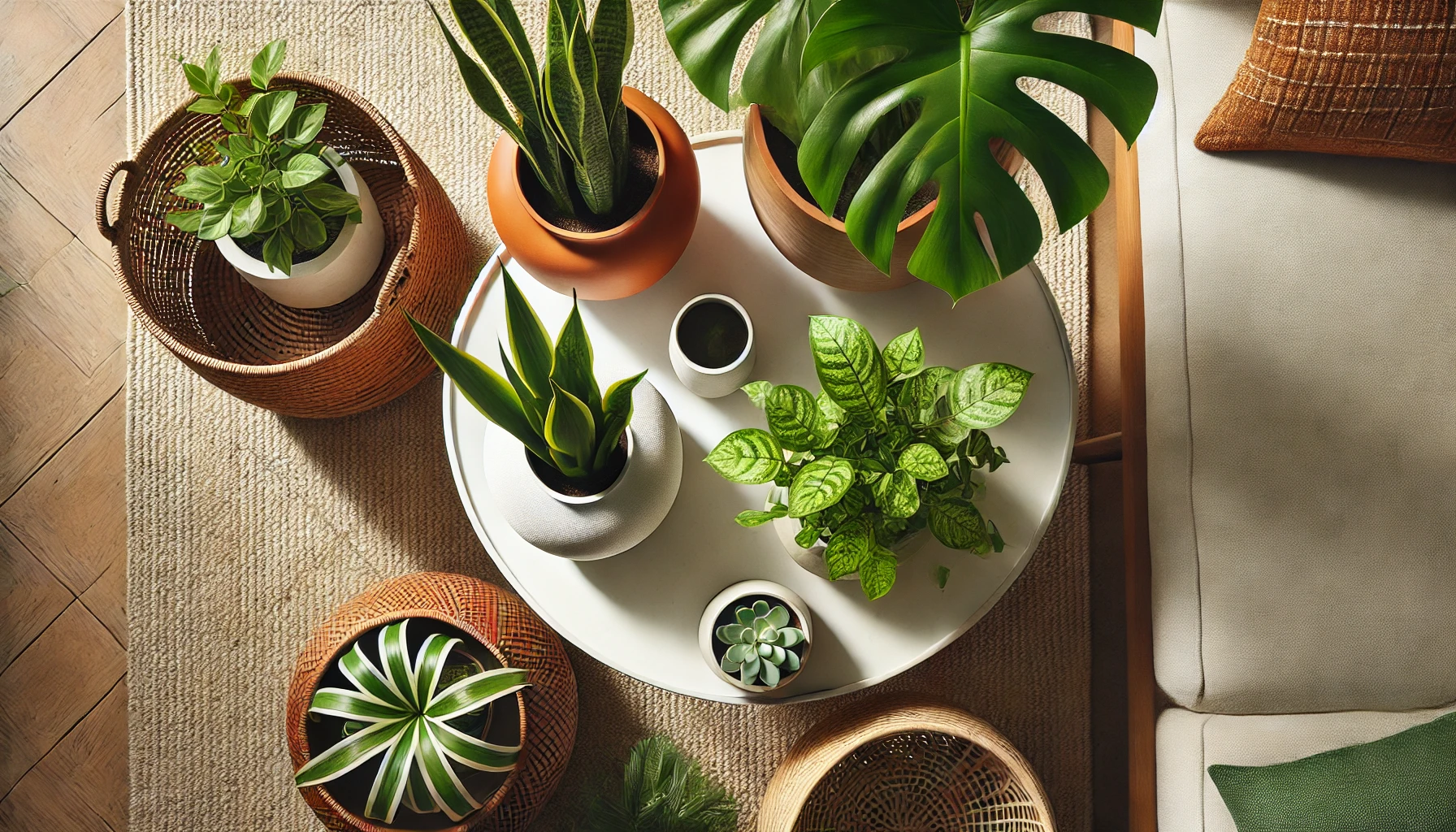
🌿 Blending Natural Elements
- Combine wooden furniture with leafy green plants to bring warmth.
- Pair metallic or glass furniture with sleek, structured plants for a modern look.
- Use woven baskets, ceramic pots, or stone planters to enhance texture variety and make the space feel more organic.
By thoughtfully coordinating colors and textures, you can create a beautifully balanced home where furniture and greenery work in perfect harmony 🌸✨.
Practical Placement Tips 🌿🏡
Placing plants strategically can enhance both their beauty and functionality in your space. Here’s how to position them like a pro:
🌟 Use Corners & Empty Spaces Wisely
- Place tall plants (e.g., fiddle leaf fig, rubber plant) in bare corners to add life and depth.
- Use a plant stand or tiered shelving to create height variation and maximize space.
🪑 Balance Plants Around Furniture
- Frame your sofa or reading nook with matching plants on either side for symmetry.
- Add small plants to coffee tables, side tables, or bookshelves for a subtle, stylish touch.
🪴 Elevate with Hanging & Wall Plants
- Hang trailing plants (e.g., pothos, string of pearls) near windows or in small rooms to save floor space.
- Use floating shelves to display plants at different heights for a layered look.
☀️ Consider Light & Accessibility
- Place sun-loving plants (e.g., succulents, aloe vera) near windows for proper growth.
- Keep low-maintenance plants (e.g., snake plant, ZZ plant) in shaded spots or busy areas where frequent care isn’t needed.
- Ensure plants are easy to water and trim—avoid placing them where they’re hard to reach!
🚶 Maintain Walkways & Traffic Flow
- Avoid putting large plants in high-traffic areas where they may be knocked over.
- Keep entryways clear by using compact or wall-mounted plants to save space.
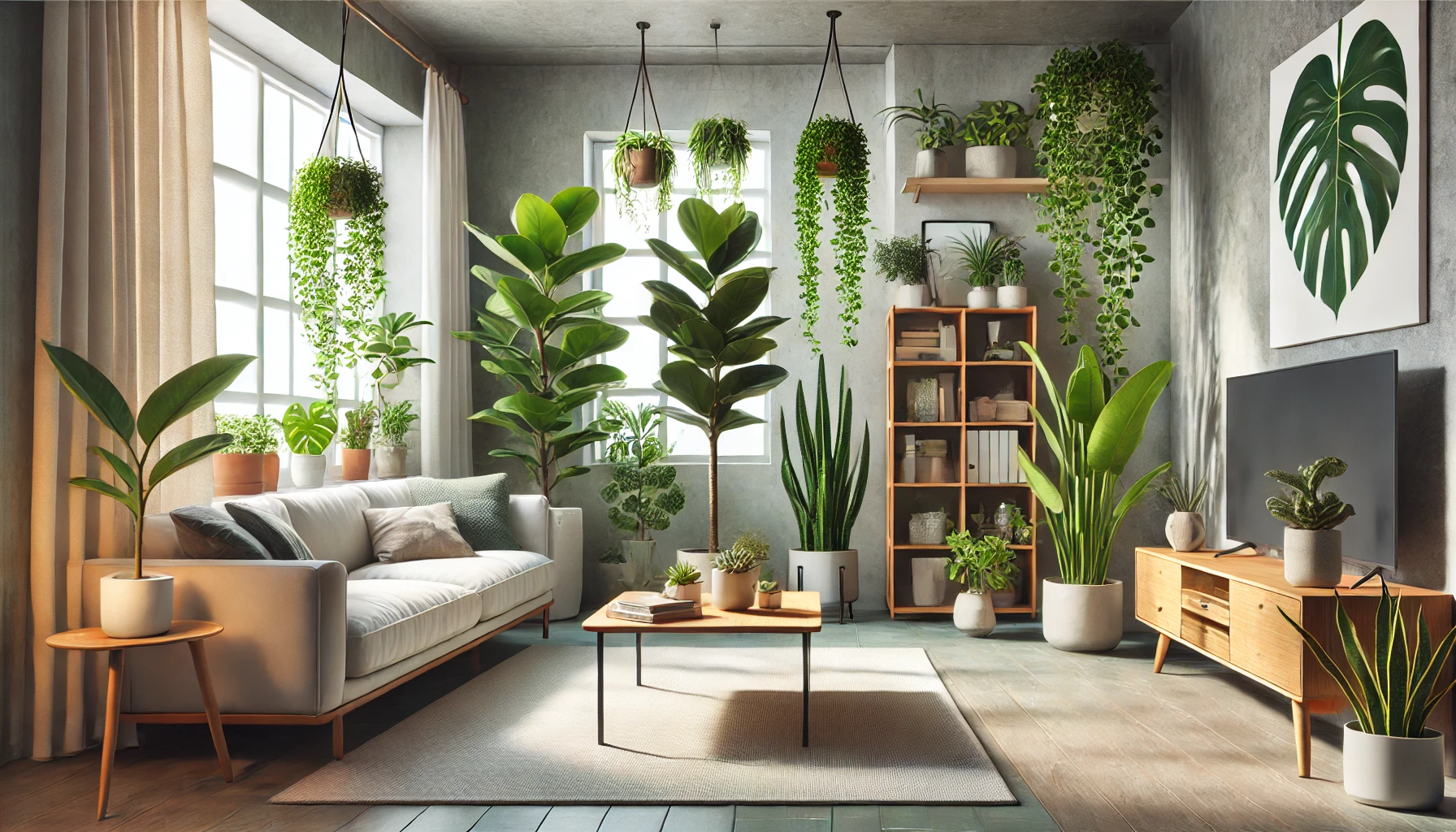
With smart placement, your plants will not only thrive but also enhance your home’s aesthetics without feeling cluttered 🌸✨.
Maintenance Tips for a Seamless Design 🌿✨
Keeping your plants healthy and your space looking stylish requires regular care. Here’s how to maintain a balanced and beautiful indoor setup:
🪴 Keep Plants Healthy & Thriving
- Water Wisely 💧 – Overwatering can cause root rot, while underwatering leads to droopy leaves. Check soil moisture before watering.
- Dust Leaves Regularly 🍃 – Wipe leaves with a damp cloth to keep them shiny and allow proper light absorption.
- Rotate Plants 🔄 – Turn plants occasionally so they grow evenly and don’t lean toward the light.
☀️ Adjust for Seasonal Changes
- Move plants as needed – Some may need more light in winter or shade in summer.
- Increase humidity 🌫️ – Dry indoor air in winter can stress plants. Use a humidifier or mist leaves occasionally.
📍 Maintain a Clutter-Free Look
- Prune & Trim Regularly ✂️ – Remove yellowing leaves and overgrown stems to keep plants looking neat.
- Choose the Right Planters 🏺 – Avoid bulky pots that take up too much space. Use stylish yet practical options like hanging planters or sleek ceramic pots.
- Group Similar Plants 🌱 – Place plants with similar care needs together to simplify watering and maintenance.
With these simple maintenance habits, your home will stay fresh, vibrant, and effortlessly stylish—all while keeping your indoor greenery in perfect harmony with your furniture! 🌸💚
Common Mistakes to Avoid ❌🌿

Balancing furniture and indoor greenery requires thoughtful planning. Avoid these common mistakes to keep your space stylish and functional:
🚫 Overcrowding the Space
- Too many plants can make a room feel cluttered and overwhelming. Instead, space them out and use different heights for a balanced look.
☀️ Ignoring Light Needs
- Placing a sun-loving plant in a dark corner or a low-light plant in direct sun can lead to poor growth. Match plants with the right light conditions to keep them healthy.
💧 Overwatering or Underwatering
- Overwatering causes root rot, while underwatering leads to dry, droopy leaves. Check the soil before watering and stick to a schedule based on plant needs.
📍 Placing Plants in High-Traffic Areas
- Large plants near doorways or walkways can be knocked over. Choose compact or wall-mounted plants for tight spaces to avoid accidents.
🪴 Using the Wrong Planters
- A pot without drainage can lead to root rot. Always use pots with drainage holes or add a layer of pebbles at the bottom to improve aeration.
🎨 Ignoring Color & Texture Balance
- Mismatched plant styles or clashing pot colors can disrupt your decor. Pair plants with furniture textures and colors to create a cohesive design.
By avoiding these mistakes, you’ll maintain a beautiful, well-balanced space where both your plants and furniture shine in harmony! 🌸✨
Final Thought
Creating a home where furniture and indoor greenery coexist beautifully is all about balance. By carefully selecting the right plants, placing them strategically, and maintaining them properly, you can transform your space into a stylish, refreshing, and harmonious retreat. 🌸✨
Remember to match plants to your room’s lighting and furniture style, use different heights and textures for a natural flow, and avoid common mistakes like overcrowding or poor maintenance. A well-balanced space not only looks great but also enhances your well-being by bringing nature indoors.
With these tips, you’re ready to design a home that feels alive, inviting, and effortlessly elegant. So go ahead—bring in the greenery and let your space flourish! 🌱💚
Frequently Asked Questions (FAQ)
How can I incorporate plants into my home decor without overcrowding?
Choose plants that complement your furniture size and use plant stands, shelves, or hanging planters to save space.
What are the best plants for small apartments with limited space?
Compact plants like pothos, snake plants, and succulents fit well in small spaces without overwhelming the decor.
How do I choose planters that match my furniture style?
Select pots in neutral tones for a modern look or woven and ceramic pots for a cozy, natural feel.
Can indoor plants be used as room dividers?
Yes, tall plants like fiddle leaf figs or bamboo can create natural partitions while adding greenery.
What are the best ways to display plants in a minimalist home?
Use sleek, simple pots and arrange plants in a structured way, such as a single statement plant or a row of uniform planters.
How do I balance large furniture with tall indoor plants?
Place large plants near furniture edges to frame the space or use corner placements to create a cohesive look.
Are there plant-friendly furniture options for better harmony?
Look for furniture with built-in plant shelves, wall-mounted planters, or multi-level plant stands for seamless integration.
What plants work well in living rooms with modern decor?
Fiddle leaf figs, monstera, and snake plants add bold, sculptural elements that enhance modern interiors.
